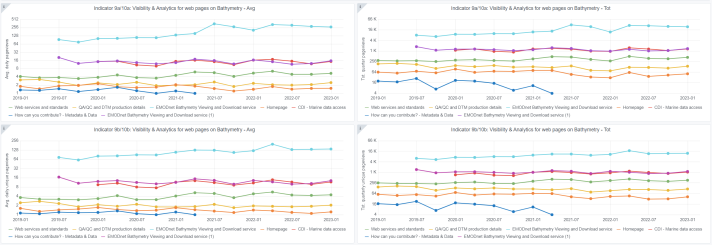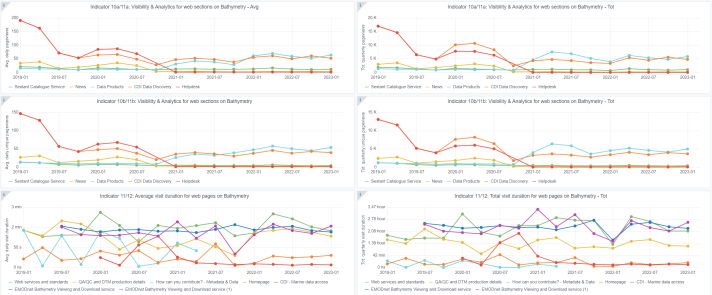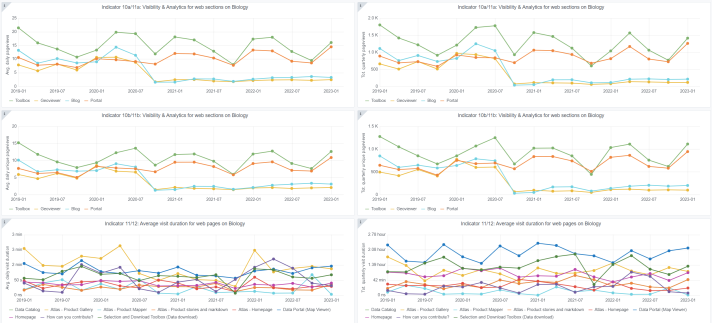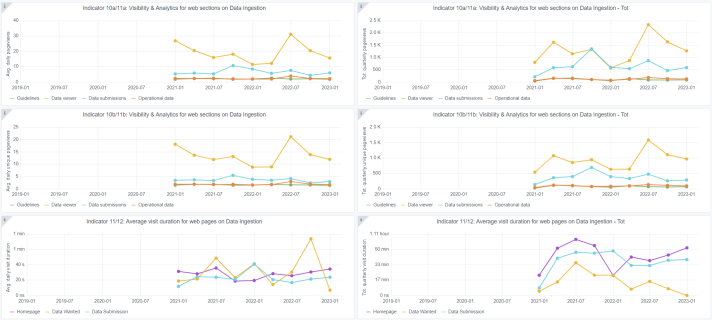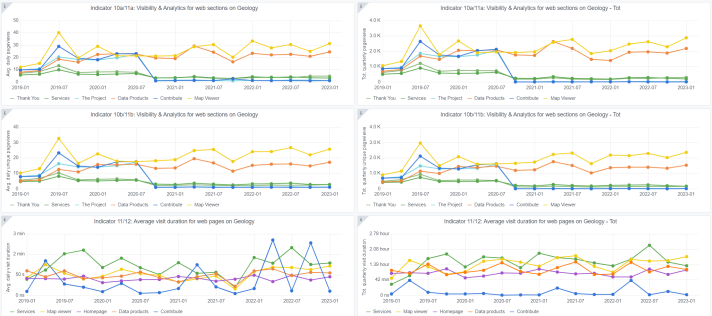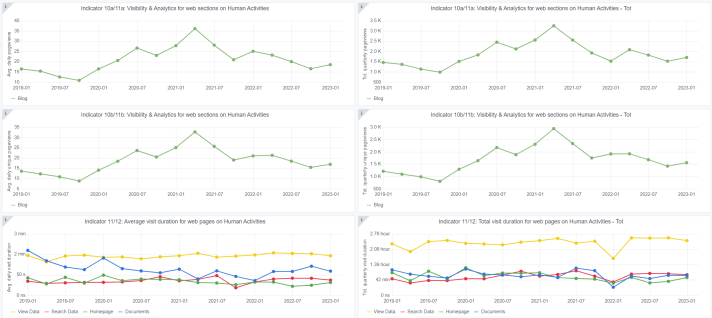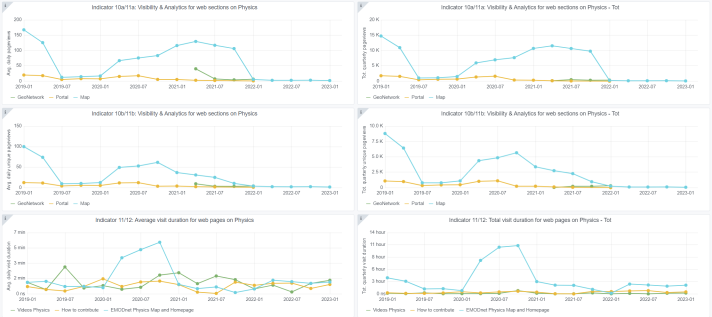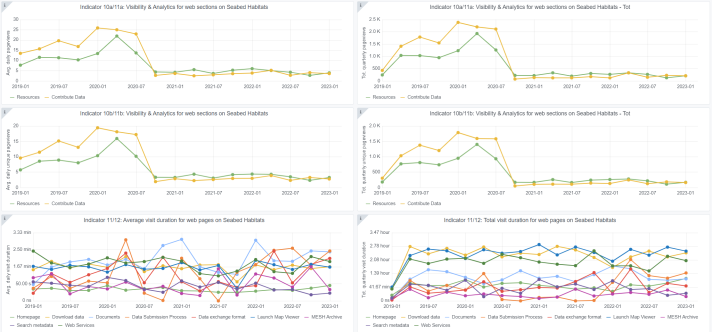EMODnet progress overview
General progress highlights
On 7 and 8 November, members of the EMODnet Steering Committee consisting of the EMODnet Secretariat, Thematic coordinators, EC DG MARE and other DGs, Contracting Authority CINEA, Technical Working Group and EC Marine Knowledge Expert Group (MKEG), gathered for the 17th EMODnet Steering Committee Meeting. The meeting took place as a hybrid meeting in Brussels, Belgium and focused on the network’s progress towards centralisation of all EMODnet data services. The EC Marine Knowledge Expert Group joined the 17th EMODnet SC Open Session and also met for a second closed session on 29th November 2022.
In the reporting period, a new use case was developed, illustrating how EMODnet data supports the Helsinki Commission, HELCOM, to manage Baltic Sea data on beach litter for the purposes of the ‘State of the Baltic Sea’ holistic assessment report.
On the 17th of February, EMODnet attended the first Annual Forum of the Mission “Restore our Ocean and Waters by 2030”. The day was marked by EMODnet launching a new video on the central role EMODnet has in delivering a public service for Marine Knowledge that underpins all the Mission Ocean objectives and cross-cutting enablers, including the Digital Ocean and Water Knowledge System. The map layer in the European Atlas of the Seas which provides information on actions submitted by the signatories of the Mission Charter was also promoted in the Map of the Week on the Maritime Forum.
On 23 November 2022, colleagues from the European Marine Observation and Data Network (EMODnet) and the National Marine Data and Information Service of China (NMDIS) gathered together with representatives from the European Commission and the Chinese Ministry of Natural Resources (MNR) at the final meeting of the EU-China collaborative ocean data pilot projects EMOD-PACE (i.e. the ‘EMODnet Partnership for China and Europe’) and CEMDnet (China-EU Marine Data Network Partnership). While the EMODnet-NMDIS collaboration will continue, the 34-month projects ended on 31 December 2022. To know what the project was all about in a nutshell, have a look at the final project video.
Specific progress and achievements of the thematic data assembly groups
- The number of survey datasets in EMODnet Bathymetry has increased from 41,252 to 41,315 Common Data Index (CDI) entries, and the number of composite Digital Terrain Model (DTM) entries increased from 269 to 274. The latter have been used in the production of the new 2022 DTM, of which the release is planned end of February 2023. A Caribbean Sea DTM has been produced, based on available data received from EU Member States (mainly France and the Netherlands). An update of the overview of official coastlines and legal baselines for all countries around Europe will be published together with the 2022 DTM. The EMODnet Bathymetry contract will be continued for another two years.
- During the report period, EMODnet Biology published 18 new submissions and updated three pre-existing datasets. The deliverable report on efforts undertaken in rescuing historical data through citizen science was published; the work was considered a successful trial, with two datasets being digitized and published via EMODnet Biology. The Zooniverse platform was considered the most potent one, but the lot emphasises that only datasets as big and homogenous as possible should be preferred for future digitisation efforts. Progress continues in the development of the latest suite of products, with a delivery timeline agreed in the first quarter of 2023. EMODnet Biology aims to work with relevant parties to elucidate and advance the aims of a European Marine Biodiversity Observation Network (EU MBON).
- In EMODnet Chemistry, the six regional leaders were involved in generating DIVA (Data-Interpolating Variational Analysis) interpolated maps, each for selected eutrophication parameters, and a series of meetings were organised to align the process. The Marine Strategy Framework Directive (MSFD) beach litter data collected by EU Member States during 2015-2021 were harvested and prepared for delivery to the EC JRC (Joint Research Centre). In the reporting period, the thematic lot participated in the Technical Group on Marine Litter (TG ML). The possibility of EMODnet Chemistry playing an active role in the collection of MSFD monitoring data for Descriptors 5 and 9 was discussed and proposed to the Member States’ representatives.
- In the quarterly period, EMODnet Data Ingestion received 60 submissions, pushing the total number of received submissions so far to 1,308. The total number of published data submissions increased from 1,119 to 1,176. There were 19 new SEANOE datasets harvested by the ingestion service. All partners contributed to the inventory of potential data sources; 230 data sources from 25 countries and 35 institutes were identified. Partners will use the inventory to give a follow-up in their countries. For the task on improving and documenting the availability of data provided for coastal and offshore licensing, all partners/countries have contributed at least one stakeholder. In a second step, further surveys and contacts with the stakeholders will be done to make available relevant documentation and information on data collection and licensing processes.
- EMODnet Geology project data deliveries continued, especially for the Caspian Sea and Caribbean Sea. It was estimated that in the first project year, about 415,000 km² of new and updated data was received, in addition to almost 11,000 km of line data and a few hundred point data to the different work packages. The majority of the data is to be submitted during the second project year, estimated to be over 1,000,000 additional km². A part of the data is update of older data with lower resolution or quality; a few percent of areal increase can be expected. A subcontract was signed between EMODnet Geology and the Azerbaijani partner Caspian Locus Limited Liability Company, who immediately started with the work to access and harmonize data to the different work packages of EMODnet Geology.
- EMODnet Human Activities updated a number of datasets (among others, Oil and gas licenses, Freshwater aquaculture and Wind farms) as well as the Route density maps (updated to December 2022). The thematic investigated possible new data products related to cultural heritage, based on data sent through Data Ingestion by the Marine Institute Ireland, in particular the World Heritage List of the UNESCO. The company Teleography, a U.S.A. commercial company that used to provide data on cables (schematic routes) decided to cease extending EMODnet’s right to use their data; hence the dataset was removed from the EMODnet Human Activities portal.
- EMODnet Physics updated and released a number of products, i.e. the EMODnet Registry of continuous noise monitoring sites and the Coriolis Ocean database for ReAnalysis. During the reporting period, activities focused on cleaning and fine-tuning data collection to support the Central Portal Technical Team. In addition, the team kept working on the GetFeatureInfo and in particular the INFO_FORMAT=text/html property.
- EMODnet Seabed Habitats made good progress towards updating the EUSeaMap data product. Among others, the broad habitat types and input data to be used for the Caspian Sea were agreed at a workshop in November; for the Caribbean Sea the broad habitat types were defined based on existing EUNIS-like classifications; and Python scripts were developed allowing users to prepare raster data products on the hydrodynamic conditions at the seabed, using hydrodynamic models from CMEMS and the digital elevation model from EMODnet Bathymetry as inputs, for an area and time period of interest. The thematic finalised the list of composite data products that they plan to produce in the second year of their contract. Several ideas about Wetland type map products were discussed among partners.
EMODnet data portals usage
User visit statistics
User statistics (i.e. number of ‘unique’ page views and average visit duration) are collected through an EMODnet Matomo instance managed by VLIZ, which is automated for the following progress/monitoring indicators: Visibility & Analytics for web pages; Visibility & Analytics for web sections; and Average visit duration for web pages (note that Matomo will gradually be replaced by ‘Europa Analytics’ as thematic portals are integrated into the Central Portal). The resulting graphs for each EMODnet thematic lot as well as the Central Portal can be viewed in the gallery at the end of this report. Unless stated otherwise, page views and visit durations are average per day and trends are compared to the previous quarter.
- Compared to the previous quarter, the number of average daily pageviews remained fairly constant for the EMODnet Bathymetry webpages; the EMODnet Bathymetry Viewing and Downloading Service remained the most visited webpage (284 pageviews in this quarter), and the Homepage the least visited (2 pageviews in this quarter).
- Increases were observed in the average number of daily pageviews for most EMODnet Biology webpages; on average 15 pageviews were recorded for the Homepage, 9.5 for the Data Portal Map Viewer and 1 for the Atlas Product Mapper.
- Visitors of EMODnet Data Ingestion primarily visited the Homepage (8.4 average daily pageviews), followed by the Data Submission service (6) and Data Wanted service (2).
- For EMODnet Geology fairly constant average pageviews were observed, ranging between 21 (Homepage), 9 (Map viewer) and 1 (Contribute).
- Slight increases were observed in the number of average pageviews for EMODnet Human Activities: 99 for the View data page, 45 for the Homepage and 18 for Search data.
- Fairly constant average pageviews were observed for EMODnet Physics. The EMODnet Physics Map and Homepage received an average of 18 pageviews, and the Physics Videos an average of 2.
- Fairly stable trends were observed in the number of average daily pageviews for the EMODnet Seabed Habitats webpages. The Launch Map Viewer received the most pageviews (21), followed by the Homepage (10.5) and Download data (11).
Statistics on usage of EMODnet portals[1]
Number of data downloads[2]
- There was a decrease of 10.5% in number of downloaded CDIs from EMODnet Bathymetry compared to previous quarter, i.e. from 187,869 CDIs to 167,800. The number of users decreased from 28 to 17.
- An increase of almost 50% was observed in the number of manual data download requests from 200 to 359 on the EMODnet Biology thematic portal, accounting for a total of over 30 million downloaded occurrence records.
- An increase of 61% was recorded in the number of CDI manual downloads for EMODnet Chemistry (from 6,764 to 17,400 CDIs).
- EMODnet Data Ingestion recorded an increase in number of data download transactions, from nearly 160 to 232 (increase of 45%).
- Overall, number of data downloads increased in EMODnet Human Activities; the sum of the number of dataset downloads equals 3,501 compared to 2,243 previous quarter). Among the most downloaded datasets were Wind Farm locations (500), Cables Landing Stations (230), and Goods, Passengers, Vessels (Main ports) (201).
- Compared to the previous quarter, predominantly increases were observed in the number of data download requests for EMODnet Physics. A total of 425 data download requests were done, compared to 114 in the previous quarter. Download requests ranged from 0 (Atmospheric parameters), to 95 (River).
- In this quarter, an increase in the number of manually downloaded records was recorded for EMODnet Seabed Habitats’ dataset “collection of classified points”, from 15,979,233 to 25,854,530 (+62%).
Number of data product downloads[3]
- An increase was recorded in the number of downloads of EMODnet Bathymetry DTM tiles (from 11,671 to more than 13,000 downloads) and a decrease in number of and High-Resolution DTMs (from 1,829 to 552 downloads). The Satellite Derived Coastlines were downloaded 69 times (compared to 45 in the previous quarter).
- EMODnet Biology observed three data product downloads, compared to one in the last quarter.
- There was a decrease in the number of data product file downloads for eutrophication from EMODnet Chemistry. The decreases ranged between -40% and -52%, reflecting file download numbers between 72 and 88 respectively. The number of data product file downloads increased for contaminants and marine litter (113 and 109 downloads respectively).
- For most EMODnet Geology data products, the number of data product downloads increased and range between 12 (Seabed Substrate Acceleration rates) and 52 (Seabed Substrate 250k and Seafloor Geology). Less downloads were documented for Seabed Substrate Multiscale (33 compared to 41 in the previous quarter) and Events and Probabilities (20 compared to 30).
- Compared to the previous quarter, the number of dataset downloads increased for EMODnet Human Activities. Of the “Vessel density maps”, 1,991 dataset downloads were done (compared to 1,352 previous quarter); and of the “Route density maps”, 735 dataset downloads were performed (compared to 279 previous quarter).
- Decreases in the number of download transactions (through ERDDAP, from 5,780,395 to 256,480) were observed for the products of EMODnet Physics.
- There is an overall increase in download of product datasets across the various EMODnet Seabed Habitats sub-themes. In total, 93,289 datasets were downloaded, compared to 53,630 in the previous quarter. Most downloaded product dataset was Habitats - seabed habitats (including coastal wetlands) - collection of classified maps.
Recent meetings and events
In the third quarter of 2022, a mixture of remote, hybrid and physical events were organized and/or attended by the EMODnet thematic lots. A few key meetings included the following:
- EMODnet Bathymetry attended the Annual GEBCO meetings on SEABED 2030 progress (26-28 October) and attended the International Hydro 2022 Conference (6-8 December).
- EMODnet Biology attended the 2022 EuropaBON Conference in collaboration with Biodiversa+ (8 November) and a small workshop targeting specific organisations/initiatives to contribute to DASSH's (Archive for Marine Species and Habitats Data) future developments (17 October).
- EMODnet Chemistry organised a webinar (attended online and onsite) on EMODnet Chemistry (13 October), attended a workshop organised by UNESCO Global Partnership on Marine Litter (GPML) on plastic pollution (20 October), and attended a Community of Practice (CoP) meeting by GPML as a member of the CoP (10 October).
- EMODnet Data Ingestion was promoted at a number of events such as the 1st International MARBLUE Conference “Blue Growth: Challenges and opportunities for the Black Sea” (26-28 October) and the EU-Canada Ocean Partnership meeting (3-4 October).
- EMODnet Geology gave several lectures on EMODnet Geology, at the University of Helsinki, Faculty of Biological and Environmental Sciences (4 October) and at the Åbo Akademi University (Turku, Finland; 1 December).
- EMODnet Human Activities presented at the Technical Expert Group on Data for Marine Spatial Planning (MSP) (5 December) and has a meeting call with the U.S.A. Coast Guard to discuss how to use EMODnet’s method for vessel density mapping (14 December).
- EMODnet Physics attended as a key stakeholder in a number of meetings, among others the DATAMEQ - EuroGOOS Data Management, Exchange, and Quality Working Group (DATAMEQ WG) (14 October), the H2020 flagship project NAUTILOS (26 October) and OCEANICE (7 November).
- EMODnet Seabed Habitats attended the Copernicus Biodiversity and coastal ecosystems workshop to promote EMODnet data and products of use for coastal biodiversity protection (11 October) and attended several meetings of the European Marine Board Working Group on Marine Habitat Mapping (21 October, 24 October, 24 November).
Upcoming EMODnet meetings and events
The main EMODnet meeting planned for the coming period in 2023 is:
- The third edition of the EMODnet Open Sea Lab (OSL 3.0) Hackathon is taking place on 27-28 March. Registrations are still open and close on the 14th of March!
More information
More information about EMODnet’s resources is available at the following links:
- EMODnet Data and Data product portfolio: https://emodnet.ec.europa.eu/en/data-portfolio
- EMODnet for Business brochure: https://emodnet.ec.europa.eu/en/emodnet-business-brochure
Thematic portals
- EMODnet Bathymetry - www.emodnet-bathymetry.eu
- EMODnet Geology - www.emodnet-geology.eu
- EMODnet Seabed habitats - www.emodnet-seabedhabitats.eu
- EMODnet Physics - www.emodnet-physics.eu
- EMODnet Chemistry - www.emodnet-chemistry.eu
- EMODnet Biology - www.emodnet-biology.eu
- EMODnet Human Activities - www.emodnet-humanactivities.eu
Data Ingestion Service
- Ingestion and safe-keeping of marine data - www.emodnet-ingestion.eu
Sea-basin Checkpoints resources
For an overview of and access to information and outputs from each of the Sea-basin Checkpoints (projects ended), visit: https://emodnet.ec.europa.eu/en/checkpoints
- North Sea checkpoint - https://emodnet.ec.europa.eu/en/checkpoint/north-sea
- Mediterranean checkpoint - https://emodnet.ec.europa.eu/en/checkpoint/medsea
- Artic checkpoint - https://emodnet.ec.europa.eu/en/checkpoint/arctic
- Atlantic checkpoint - https://emodnet.ec.europa.eu/en/checkpoint/atlantic
- Baltic checkpoint - https://emodnet.ec.europa.eu/en/checkpoint/baltic
- Black Sea checkpoint - https://emodnet.ec.europa.eu/en/checkpoint/black-sea
[1] For portals which provided this information.
[2] Disclaimer: please note that percentages given can reflect small as well as large changes in the number of data and data product downloads. Note: Most thematic groups assigned reported decreases in the number of downloads to the COVID-19 situation and summer period. In most cases however it is difficult to provide an actual explanation for the downloading behaviour of users.
[3] Disclaimer: please note that percentages given can reflect small as well as large changes in the number of data and data product downloads. Note: Most thematic groups assigned reported decreases in the number of downloads to the COVID-19 situation and summer period. In most cases however it is difficult to provide an actual explanation for the downloading behaviour of users.

